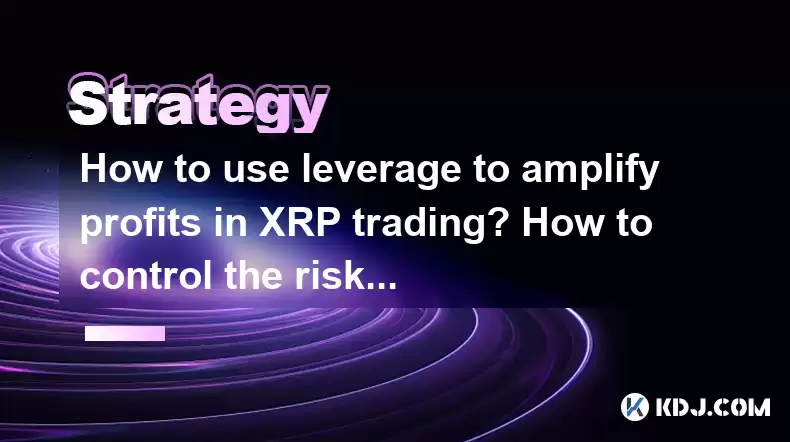-
 bitcoin
bitcoin $110918.433029 USD
-1.69% -
 ethereum
ethereum $3996.872473 USD
-2.43% -
 tether
tether $1.000594 USD
0.00% -
 bnb
bnb $1178.871834 USD
-2.38% -
 xrp
xrp $2.413973 USD
-3.47% -
 solana
solana $194.341461 USD
-4.24% -
 usd-coin
usd-coin $0.999963 USD
-0.03% -
 tron
tron $0.320092 USD
0.92% -
 dogecoin
dogecoin $0.196919 USD
-3.42% -
 cardano
cardano $0.669585 USD
-3.63% -
 hyperliquid
hyperliquid $37.485952 USD
-3.58% -
 ethena-usde
ethena-usde $1.000026 USD
-0.02% -
 chainlink
chainlink $18.018220 USD
-5.13% -
 bitcoin-cash
bitcoin-cash $523.879267 USD
-2.41% -
 stellar
stellar $0.324655 USD
-3.67%
How to use leverage to amplify profits in XRP trading? How to control the risk of liquidation
Leverage in XRP trading can boost profits but also risks liquidation; use stop-loss orders and monitor margin levels to manage these risks effectively.
Apr 28, 2025 at 02:15 pm

Trading XRP with leverage can significantly amplify your potential profits, but it also comes with increased risks, including the possibility of liquidation. Understanding how to use leverage effectively and manage the risk of liquidation is crucial for any trader looking to engage in leveraged trading of XRP. This article will guide you through the process of using leverage to enhance your XRP trading and provide strategies to control the risk of liquidation.
Understanding Leverage in XRP Trading
Leverage in trading allows you to control a larger position with a smaller amount of capital. For example, if you use 10x leverage, you can control a position worth 10 times your initial investment. This means that if XRP's price moves in your favor, your profits are magnified. However, the downside is equally amplified; if the price moves against you, your losses can exceed your initial investment.
When trading XRP with leverage, you typically borrow funds from your broker or exchange to increase your trading position. The amount of leverage available can vary from one platform to another, but common leverage ratios for XRP trading include 2x, 5x, 10x, and even higher.
How to Use Leverage in XRP Trading
To start using leverage in XRP trading, follow these steps:
Choose a Trading Platform: Select a reputable cryptocurrency exchange or broker that offers leveraged trading for XRP. Some popular platforms include Binance, Kraken, and BitMEX.
Open an Account: If you don't already have an account, sign up and complete the verification process. This may involve providing personal information and submitting identification documents.
Deposit Funds: Fund your account with the cryptocurrency or fiat currency required by the platform. Ensure you have enough capital to cover the margin requirements for the leverage you intend to use.
Select Leverage: Once your account is funded, navigate to the XRP trading section and choose the desired leverage level. This is usually done through a dropdown menu or a slider on the trading interface.
Place a Trade: Decide whether you want to go long (buy) or short (sell) XRP. Enter the amount you wish to trade, and confirm the order. The platform will automatically calculate the total position size based on the leverage you've selected.
Monitor Your Position: Keep a close eye on the XRP market and your open positions. Use stop-loss orders and other risk management tools to protect your investment.
Amplifying Profits with Leverage
Using leverage can significantly increase your potential profits in XRP trading. Here's how:
Increased Exposure: With leverage, you can control a larger position than your capital would normally allow. For instance, if you have $1,000 and use 10x leverage, you can control a $10,000 position. If XRP's price increases by 1%, your profit would be $100 (1% of $10,000), compared to just $10 without leverage.
Magnified Returns: The potential returns on your investment are magnified by the leverage ratio. If XRP's price moves in your favor, the percentage gain on your initial investment can be much higher than without leverage.
Flexibility: Leverage allows you to take advantage of short-term market movements without tying up a large amount of capital. This can be particularly useful in the volatile cryptocurrency market.
Controlling the Risk of Liquidation
While leverage can amplify profits, it also increases the risk of liquidation. Liquidation occurs when the value of your position falls below the maintenance margin level, and the broker or exchange closes your position to cover the losses. To control this risk, consider the following strategies:
Use Stop-Loss Orders: A stop-loss order automatically closes your position if the price of XRP reaches a certain level, limiting your potential losses. Set your stop-loss at a level that allows for some market volatility but protects your capital.
Monitor Margin Levels: Keep an eye on your margin level, which is the ratio of your equity to the total position size. If the margin level falls below the maintenance margin, you risk liquidation. You can add more funds to your account or reduce your position size to maintain a healthy margin level.
Diversify Your Portfolio: Don't put all your capital into a single leveraged position. Diversify your investments across different assets and strategies to spread the risk.
Use Lower Leverage: While higher leverage can lead to higher profits, it also increases the risk of liquidation. Consider using lower leverage ratios, such as 2x or 5x, to reduce the risk while still benefiting from leverage.
Stay Informed: Keep up-to-date with market news and trends that could affect XRP's price. Being informed can help you make better trading decisions and anticipate potential price movements.
Practical Example of Using Leverage in XRP Trading
Let's consider a practical example to illustrate how leverage works in XRP trading:
- Initial Investment: You have $1,000 in your trading account.
- Leverage: You decide to use 10x leverage.
- Position Size: With 10x leverage, you can control a position worth $10,000.
- Trade: You go long on XRP, expecting the price to rise.
- Price Movement: XRP's price increases by 5%.
In this scenario, your profit would be calculated as follows:
- Profit Without Leverage: $1,000 x 5% = $50
- Profit With Leverage: $10,000 x 5% = $500
However, if XRP's price had fallen by 5% instead, your loss would be:
- Loss Without Leverage: $1,000 x 5% = $50
- Loss With Leverage: $10,000 x 5% = $500
This example demonstrates the potential for both higher profits and higher losses when using leverage. It's essential to manage these risks carefully.
Frequently Asked Questions
Q1: Can I use leverage on all cryptocurrency exchanges?A1: Not all cryptocurrency exchanges offer leveraged trading. It's important to check the features of each platform to see if they support leverage for XRP trading. Some well-known exchanges that do offer leverage include Binance, Kraken, and BitMEX.
Q2: What happens if I get liquidated?A2: If you get liquidated, your position will be automatically closed by the exchange or broker to cover the losses. Any remaining funds in your account after the liquidation will be available for withdrawal or further trading. It's crucial to monitor your positions and use risk management tools to avoid liquidation.
Q3: Is it possible to change the leverage level after opening a position?A3: Some trading platforms allow you to adjust the leverage level on an open position, while others do not. Check the specific rules and features of your chosen platform to see if this is an option. Adjusting leverage can help manage risk, but it's important to understand the implications of such changes.
Q4: How does the margin requirement affect my trading?A4: The margin requirement is the amount of capital you need to have in your account to open and maintain a leveraged position. If the value of your position falls and your equity drops below the margin requirement, you risk liquidation. Always ensure you have enough funds to meet the margin requirements of your trades.
Disclaimer:info@kdj.com
The information provided is not trading advice. kdj.com does not assume any responsibility for any investments made based on the information provided in this article. Cryptocurrencies are highly volatile and it is highly recommended that you invest with caution after thorough research!
If you believe that the content used on this website infringes your copyright, please contact us immediately (info@kdj.com) and we will delete it promptly.
- DOGE, AlphaPepe, and the Crypto Explosion: What's Next?
- 2025-10-17 04:25:14
- Dogecoin, Bitcoin, and Ethereum: Navigating the Crypto Current
- 2025-10-17 04:25:14
- Dogecoin, Shiba Inu, and Remittix: Meme Coins vs. Real Utility
- 2025-10-17 05:05:14
- Toncoin's Next Move: Catalysts and Considerations for Investors
- 2025-10-17 05:05:14
- KGeN Token's Wild Ride: Price Surge, Plunge, and What It Means for Crypto
- 2025-10-17 05:10:01
- Coinbase, Altcoins, and DeepSnitch AI: Navigating the Crypto Landscape
- 2025-10-17 04:45:14
Related knowledge

Practical parameter settings for a Bitcoin multi-timeframe moving average system
Sep 18,2025 at 10:54pm
Optimizing Timeframe Combinations for Bitcoin Trading1. Selecting appropriate timeframes is crucial when building a multi-timeframe moving average sys...

How can I filter out false breakouts in Dogecoin high-frequency trading?
Sep 22,2025 at 01:00am
Understanding False Breakouts in Dogecoin Trading1. A false breakout occurs when Dogecoin's price appears to move beyond a defined support or resistan...

Techniques for identifying tops and bottoms in the Bitcoin on-chain NVT model
Sep 20,2025 at 07:54pm
Understanding the NVT Model in Bitcoin Analysis1. The Network Value to Transactions (NVT) ratio is often described as the 'P/E ratio' of the cryptocur...

What does the surge in open interest in Bitcoincoin futures mean?
Sep 20,2025 at 11:18pm
Understanding the Surge in Dogecoin Futures Open Interest1. A surge in open interest within Dogecoin futures indicates a growing number of active cont...

How can I use the Ethereum USDT premium to gauge market sentiment?
Sep 18,2025 at 11:55pm
Understanding the Ethereum USDT Premium1. The Ethereum USDT premium refers to the price difference between USDT (Tether) traded on Ethereum-based plat...

What should I do if Ethereum staking yields decline?
Sep 20,2025 at 06:18am
Understanding the Causes Behind Declining Ethereum Staking Yields1. The Ethereum network transitioned to a proof-of-stake consensus mechanism with the...

Practical parameter settings for a Bitcoin multi-timeframe moving average system
Sep 18,2025 at 10:54pm
Optimizing Timeframe Combinations for Bitcoin Trading1. Selecting appropriate timeframes is crucial when building a multi-timeframe moving average sys...

How can I filter out false breakouts in Dogecoin high-frequency trading?
Sep 22,2025 at 01:00am
Understanding False Breakouts in Dogecoin Trading1. A false breakout occurs when Dogecoin's price appears to move beyond a defined support or resistan...

Techniques for identifying tops and bottoms in the Bitcoin on-chain NVT model
Sep 20,2025 at 07:54pm
Understanding the NVT Model in Bitcoin Analysis1. The Network Value to Transactions (NVT) ratio is often described as the 'P/E ratio' of the cryptocur...

What does the surge in open interest in Bitcoincoin futures mean?
Sep 20,2025 at 11:18pm
Understanding the Surge in Dogecoin Futures Open Interest1. A surge in open interest within Dogecoin futures indicates a growing number of active cont...

How can I use the Ethereum USDT premium to gauge market sentiment?
Sep 18,2025 at 11:55pm
Understanding the Ethereum USDT Premium1. The Ethereum USDT premium refers to the price difference between USDT (Tether) traded on Ethereum-based plat...

What should I do if Ethereum staking yields decline?
Sep 20,2025 at 06:18am
Understanding the Causes Behind Declining Ethereum Staking Yields1. The Ethereum network transitioned to a proof-of-stake consensus mechanism with the...
See all articles










































































